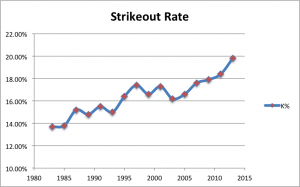Behind the Curve (Pt. 1)
Strikeouts.
We all heard a lot about them in 2013 and if you’ve been paying attention, you’ve probably noticed that they have been on the rise for a while now. Throughout the game, more batters are striking out and pitchers are accumulating K’s at a higher rate. The relationship between pitched strikeouts and strikeouts by batters is obvious, but let’s take a look at how the median strikeout rate by major league teams has changed over the last thirty years:
If that’s not a trend, I don’t know what is. Strikeouts are up, noticeably, but why? When we look at power numbers, they are up somewhat, too.
While the trend jumps more sporadically than strikeout rate does (thank you, steroids), power is still up across the time span. Apparently, hitters have traded strikeouts for power. As one can imagine, strikeouts are a lot more tolerable when you’re frequently hitting for extra bases or putting the ball over the fence.
So are the Diamondbacks following this trend?
In two words: not exactly. Arizona ranked 13th in the National League in strikeout rate (18%), with only the Cardinals and Giants striking out less often. On the one hand, this is great because the Diamondbacks are making a ton of contact. They are striking out less often than almost every other team in the league and giving themselves a chance by putting the ball in play.
But not all contact is created equal.
Arizona ranked tenth in the National League in isolated slugging (ISO). They hit for little power on the year, finishing 11th in the NL in home runs and 10th in wRC+. Yes, they made a lot of contact, but they didn’t capitalize on it. There were a lot of hollow singles hit with nothing to back them up as the team was 8th in the NL in hitting with runners in scoring position. Simply put, although they didn’t strike out a lot, that didn’t necessarily mean that they dominated at the plate.
While the rest of baseball has been trading strikeouts for power, the 2013 Diamondbacks clearly didn’t get the memo. They’re going to have to make strides in the power department in 2014 if they want to make a serious run. With that said, at least they have some strikeouts they can sacrifice in the process.
One Response to Behind the Curve (Pt. 1)
Leave a Reply Cancel reply
Recent Posts
@ryanpmorrison
 Best part of Peralta’s 108 mph fliner over the fence, IMHO: that he got that much leverage despite scooping it out… https://t.co/ivBrl76adF, Apr 08
Best part of Peralta’s 108 mph fliner over the fence, IMHO: that he got that much leverage despite scooping it out… https://t.co/ivBrl76adF, Apr 08 RT @OutfieldGrass24: If you're bored of watching Patrick Corbin get dudes out, you can check out my latest for @TheAthleticAZ. https://t.co/k1DymgY7zO, Apr 04
RT @OutfieldGrass24: If you're bored of watching Patrick Corbin get dudes out, you can check out my latest for @TheAthleticAZ. https://t.co/k1DymgY7zO, Apr 04 Of course, they may have overtaken the league lead for outs on the bases just now, also...
But in 2017, Arizona ha… https://t.co/38MBrr2D4b, Apr 04
Of course, they may have overtaken the league lead for outs on the bases just now, also...
But in 2017, Arizona ha… https://t.co/38MBrr2D4b, Apr 04 Prior to the games today, there had only been 5 steals of 3rd this season (and no CS) in the National League. The… https://t.co/gVVL84vPQ5, Apr 04
Prior to the games today, there had only been 5 steals of 3rd this season (and no CS) in the National League. The… https://t.co/gVVL84vPQ5, Apr 04 RT @OutfieldGrass24: Patrick Corbin has a WPA of .318 and it's only the fifth inning., Apr 04
RT @OutfieldGrass24: Patrick Corbin has a WPA of .318 and it's only the fifth inning., Apr 04
Powered by: Web Designers@outfieldgrass24
 Old friend alert https://t.co/xwSHU0F8Hn, 24 hours ago
Old friend alert https://t.co/xwSHU0F8Hn, 24 hours ago Every once in a while you get a beer that's just a little off... Usually happens to me at airports., Dec 07
Every once in a while you get a beer that's just a little off... Usually happens to me at airports., Dec 07 If Pollock doesn’t sign with a team that wears red uniforms I’m going to be really disappointed. Working theory: Se… https://t.co/zHn9DqzEiD, Dec 07
If Pollock doesn’t sign with a team that wears red uniforms I’m going to be really disappointed. Working theory: Se… https://t.co/zHn9DqzEiD, Dec 07 The work here by @Britt_Ghiroli is splendid https://t.co/c8tSq0vw3T, Dec 07
The work here by @Britt_Ghiroli is splendid https://t.co/c8tSq0vw3T, Dec 07 RT @TheAthleticAZ: Plenty of #Dbacks fans gave it some time - and they still don't like the idea. The "why" from @ZHBuchanan
https://t.co/9oDlvue3fV, Dec 07
RT @TheAthleticAZ: Plenty of #Dbacks fans gave it some time - and they still don't like the idea. The "why" from @ZHBuchanan
https://t.co/9oDlvue3fV, Dec 07
Powered by: Web Designers







[…] coming back to the home runs when I try to mentally reconcile the 2013 season. In fact, last week, I linked the two of these phenomena and today I want to spin that discussion around and focus on the […]